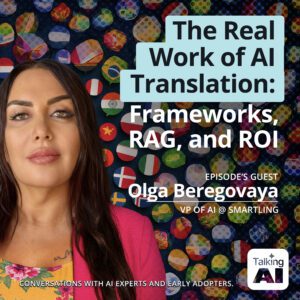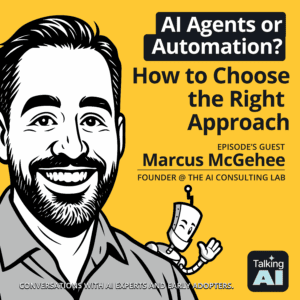Healthcare professionals today have access to a wealth of data—more than ever before.
Complex patient histories, critical medical knowledge (like the life-saving vs. life-threatening dose amounts), emerging research…the list is endless and ever-growing.
The data is important but hard to pull together at a moment’s notice. LLMs, which are trained on publicly available data, promised a lifeline but too often fall short, delivering generic responses that lack crucial context—and sometimes even hallucinating dangerous inaccuracies.
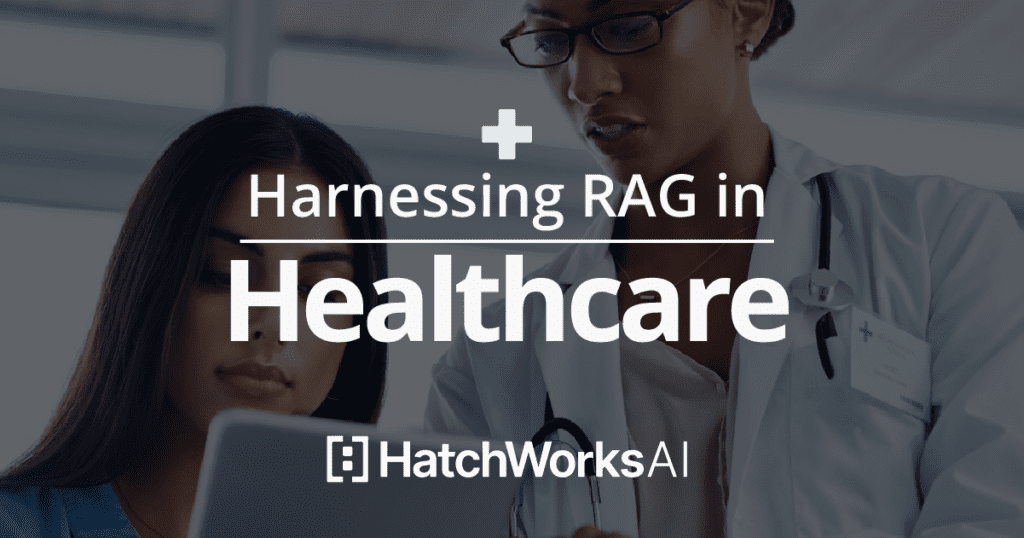
But RAG (Retrieval Augmented Generation) changes all that. It improves LLM accuracy, precision, and differentiation through your data and the latest and greatest external data.
In this article, we explain how RAG can be your competitive edge in the healthcare industry, turning your data into your most valuable asset.
Want to implement RAG right away?
Check out our RAG Accelerator here to learn how we can help.
RAG (Retrieval Augmented Generation): A Brief Definition
RAG is a methodology merging a retrieval-based AI model with a generative one.
It works by first retrieving relevant information from a large corpus of data and then generating a response or output through a large language model (LLM) based on that retrieved data.
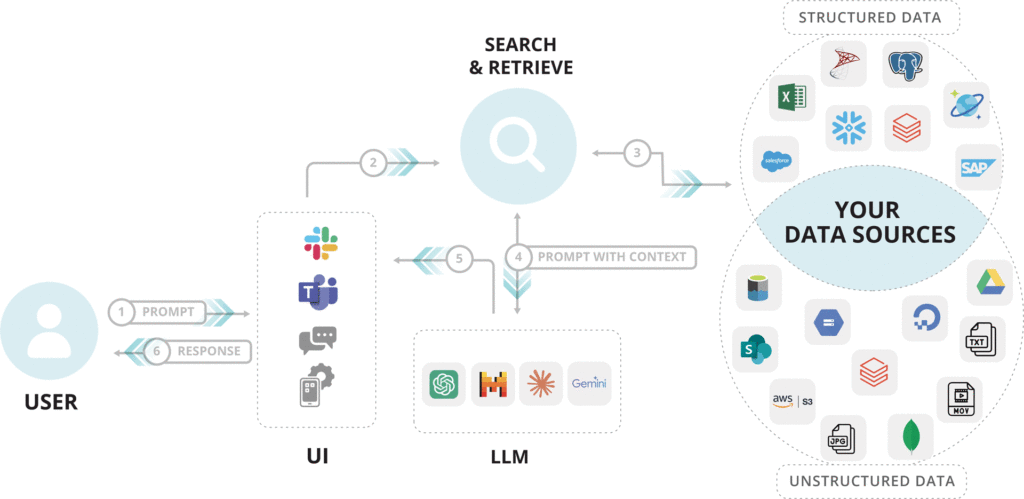
In healthcare, RAG can be used to extract and synthesize relevant information from extensive medical databases, electronic health records, and research repositories.
Think of it like an AI doctor’s assistant that understands questions and can instantly sift through millions of patient records, research papers, and treatment protocols to provide accurate, context-aware answers.
How RAG Differs from Other AI Approaches:
Common LLMs like pure generative models or rule-based systems often lack the context-specificity needed in complex fields like healthcare.
RAG vs Pure Generative Models: These large language models generate outputs based on patterns learned from training data. While they can produce coherent responses, they might not always be accurate or relevant, especially in a dynamic field like healthcare, where new research and clinical guidelines are constantly emerging.
RAG vs Rule-Based Systems: These rely on pre-defined rules and are limited by the knowledge encoded within them. They struggle to adapt to new data or unexpected scenarios and are often rigid and unable to handle the nuanced decision-making required in healthcare.
RAG addresses these limitations by ensuring that every output is directly informed by the latest, most relevant information.
And perhaps more importantly, it lets you leverage proprietary data no one else would have access to.
You can use proprietary data in RAG for:
- Personalization: It enables more personalized and relevant insights for specific patient populations.
- Competitive advantage: Organizations can differentiate themselves by offering AI-driven services based on their unique data assets.
- Data security: Sensitive healthcare data remains within the organization’s control while still being utilized for AI-driven insights.
- Continuous improvement: As the organization accumulates more relevant data, the RAG system can continuously refine and improve its outputs.
And when you use your own data—data you can trust—you’re less likely to get hallucinations other AI models are known for.
Why Healthcare Needs RAG
Data Security
Accuracy
Relevance
Healthcare is a high-stakes game. Every decision can have profound consequences, and the margin for error is razor-thin.
An incorrect diagnosis can lead to ongoing pain, frustration, and even death. And sharing confidential information with the wrong person violates HIPAA, leaving you susceptible to lawsuits.
So how you use AI matters. It could hurt (by hallucinating and leaking data) or it could help (by making you faster and more accurate).
RAG, more than other forms, lets you capitalize on the speed and convenience of AI without putting yourself or patients at risk.
Your data is secure thanks to access controls and the information it pulls will be accurate and up-to-date thanks to its search functionality.
With a RAG Accelerator like the one we offer at HatchWorks AI, we also guarantee your RAG implementation is HIPAA compliant.
Secure and Certified with SOC 2 Type I and HIPAA
At HatchWorks, trust and compliance are paramount. We adhere to the highest security standards, evidenced by our SOC 2 Type I and HIPAA certifications.
These certifications, verified through independent audits, ensure our systems are secure and your data is protected under strict privacy regulations. Stay informed with our real-time TrustCloud compliance program.
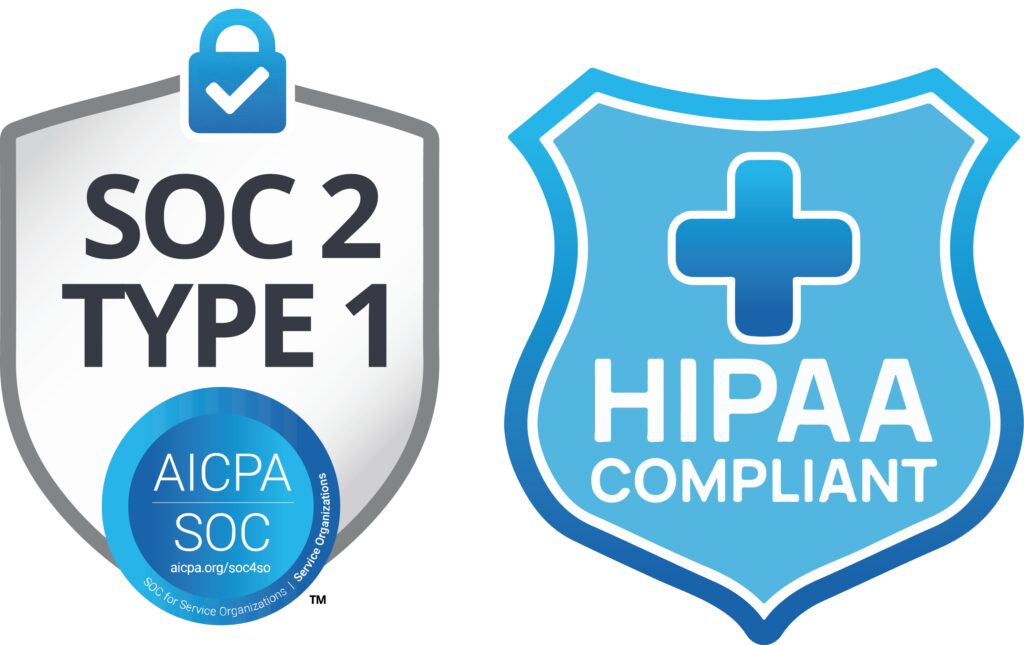
Benefits of RAG in the Healthcare Industry
Let’s look more closely at how RAG can benefit your work in the healthcare industry.Enhanced Accuracy and Precision
RAG significantly improves clinical decision-making, diagnosis, and personalized treatment by combining the latest external research with internal data sources.
For example, when a physician is diagnosing a complex condition, RAG can pull relevant studies, treatment protocols, and similar patient cases from vast datasets. And because of this, every recommendation it comes up with is informed by the most current and comprehensive data available.
This, combined with the physician’s medical knowledge, leads to more precise and accurate diagnoses and tailored treatment plans, reducing the likelihood of medical errors and improving patient outcomes.
Differentiating Through Proprietary Data
We already hinted that RAG can use proprietary data for personalization, differentiation, and refinement. But I want to flesh that out a bit because it is such a unique benefit.
Think about it: your organization has been accumulating valuable patient data, treatment outcomes, and specialized research for years.
RAG lets you capitalize on this unique data, using it to inform AI-generated responses that are specifically tailored to their patient populations and clinical environments.
Real-time Access to Up-to-date Information
With RAG, you won’t have to worry about pulling from outdated research, guidelines, or treatments.
Instead, you can count on RAG to retrieve up-to-date information like recent clinical trial results. And you’ll have near instant access to it, reducing the time needed for manual searches and enabling healthcare providers to stay on the cutting edge of medical advancements.
Overcoming Challenges
Of course, no AI system is perfect, even one bolstered with RAG capabilities. Here are three challenges we see happen the most and ways to overcome them.Challenge 1: Breaking Down Data Silos
Healthcare organizations have a lot of data but that data isn’t always easy to locate or consolidate because they’re fragmented across different systems, such as EHRs, lab reports, and billing systems.
How to overcome it: Our advice would be to invest in data integration platforms. You can also use APIs and interoperability standards like HL7 or FHIR to help facilitate data exchange across systems.
Challenge 2: Simplifying Integration Complexity
Integrating RAG models into existing healthcare IT infrastructure can be complex, especially when dealing with legacy systems.
How to overcome it: Start with a pilot project, focusing on a specific use case that offers high value with relatively low integration risk. Alternatively, you can bring in someone to build it for you.
📚You may also like to read our guide: Embrace Generative AI in 2024: A Detailed Guide for Seamless Team Integration
Challenge 3: Managing Bias in Retrieved and Generated Outputs
RAG systems can inadvertently perpetuate or even amplify biases present in the data they access.
In healthcare, this can be particularly problematic if the data retrieved by RAG models reflects historical biases, incomplete datasets, or biased research.
For example, if the model relies on datasets that underrepresent certain patient groups (such as minorities or women), it may produce biased or less accurate outputs for those groups, potentially leading to unequal or suboptimal patient care.
How to overcome it: This is a wider issue that the healthcare sector has battled for decades. Solving it will take more than just our input.
But when it comes to RAG, we recommend auditing the data your RAG models will use. You want them to be diverse, representative, and up-to-date.
There are also bias detection algorithms you could introduce to the model.
How RAG Can Be Used in Healthcare: Key Applications & Use Cases
The capabilities of RAG for healthcare are clear as are its benefits. But how can it practically be used?Clinical Decision Support Systems
RAG can help medical professionals make clinical decisions by giving them access to information for diagnostics, patient management, and treatment planning.
For example, if they need to diagnose a complex condition, a RAG model can retrieve:
- relevant patient history
- recent studies
- clinical guidelines
The clinician can use that information to arrive at the most accurate diagnosis. They can also use RAG to come up with a treatment plan based on the latest research and that patient’s medical records (taking into consideration allergies, for example).
An example of this is Apollo 24|7, a digital healthcare platform that uses Google’s MedPaLM augmented with RAG to build a Clinical Intelligence Engine (CIE).
This system assists clinicians by providing real-time access to de-identified patient data, the latest medical research, and clinical guidelines, enhancing their diagnostic and treatment planning capabilities.
By integrating RAG with MedLM, Apollo 24|7 enables clinicians to make more informed decisions, ultimately improving patient care.
Medical Research and Knowledge Management
RAG can pull and summarize relevant studies, clinical trial results, and medical publications. This is something healthcare professionals can use to accelerate the research process.
If you want to identify emerging trends or gaps in medical knowledge, RAG can help there too. That can help you stay on the front foot with scientific advancements and integrate them faster into your own organization.
Patient Engagement and Communication
RAG can help you communicate better with your patients, delivering the right information, in the right way, at the right time.
It could provide personalized health information based on the patient’s specific condition, treatment plan, and health literacy level. And it could answer patient queries in natural language, explaining complex medical concepts in terms they can understand.
This level of personalized engagement can significantly improve patient compliance and outcomes.
As highlighted by Matt Lewis, Global Chief AI Officer at Inizio Medical, in the “Talking AI” podcast, RAG plays a crucial role in enhancing patient communication by reducing the likelihood of unhelpful or irrelevant responses.
While generative AI models can sometimes produce inaccurate or off-topic information—often referred to as “hallucinations”—RAG helps mitigate this by ensuring that responses are grounded in accurate, up-to-date clinical data.
This is especially important when discussing clinical studies or treatment plans with patients, where providing consistent and understandable information is essential.
Operational Efficiency and Workflow Optimization
Beyond clinical applications, RAG can streamline administrative tasks, reducing errors and improving overall efficiency.
For example, it can automate routine tasks such as patient scheduling, documentation, and billing by retrieving necessary data from multiple sources and generating accurate, consistent outputs.
Imagine an AI that can predict patient flow in the ER and adjust staffing accordingly. That’s possible with RAG.
📚Want to learn more about LLMs to inspire your use of RAG? Check out: LLM Use Cases: One Large Language Model vs Multiple Models
What Will Your RAG Use-Case Be?
It’s time to think about how RAG can improve your organization.
Begin by asking: Where can more accurate, timely information make the biggest impact?
Consider areas where decisions depend heavily on vast, complex datasets—such as diagnostics, treatment planning, or patient communication.
Expert tip:
Determine what area of your work benefits most from integrating external data with your data.
Next, assess which of these areas could benefit from integrating external knowledge, like the latest medical research or clinical guidelines, with your proprietary data.
For example, if improving diagnostic accuracy is a priority, RAG could enhance your clinical decision support systems by providing context-specific, up-to-date information to clinicians.
If patient engagement is a challenge, RAG might help deliver personalized health content that improves understanding and adherence to care plans.
Then, work with key stakeholders—such as clinical leaders, IT staff, and patient experience teams to validate your use case ideas.
The Road Ahead: RAG’s Future in Healthcare
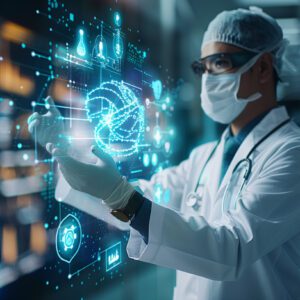 When it comes to RAG, there’s one thing we’re excited to see more of in the future: The use of RAG with predictive analysis.
When it comes to RAG, there’s one thing we’re excited to see more of in the future: The use of RAG with predictive analysis.
This combination could enable healthcare providers to access relevant historical data and forecast patient outcomes with unprecedented accuracy.
Imagine being able to predict disease progression or treatment responses based on a synthesis of global medical knowledge and individual patient data.
Another area is how much more personalized the healthcare industry will be for patients the more RAG is used.
By integrating genomic data with vast medical literature and clinical records, RAG could help tailor treatments to an individual’s genetic profile, lifestyle, and environmental factors. This could lead to more effective therapies with fewer side effects.
Introducing the RAG Accelerator: HatchWorks AI’s Solution to Your RAG Needs
Excited to work RAG into your AI adoption but overwhelmed at the prospect? We get it. It can be complex, time-consuming, and resource intensive—especially if you don’t know what you’re doing.
That’s why we created the RAG Accelerator. It’s a done-for-you implementation of RAG, allowing you to harness the power of your data without the headaches of development and integration.
HatchWorks AI’s RAG Accelerator offers:
- Customized RAG solutions built around your unique data and needs
- Seamless integration with your existing systems and workflows
- Ongoing support and updates to ensure your RAG system stays cutting-edge
- Full data security and privacy compliance, keeping your sensitive information safe
Visit our service page to learn more about how we can tailor a RAG solution for your organization, or contact us directly to schedule a consultation.
Other AI resources you might like:
Turn Your Data Into a Differentiator
Access the power of AI in your enterprise with our RAG Accelerator.

